Manual retraction of slide outs is essential for RV owners to ensure safety and convenience, especially during power failures or system malfunctions. This guide provides a comprehensive overview of the process, covering electric, hydraulic, and manual systems, to help you master the technique for secure and efficient operation.
Why Manual Retraction is Important
Manual retraction of slide outs is crucial for ensuring safety and preventing damage, especially during power failures or motor malfunctions. Automatic systems, while convenient, can fail unexpectedly, leaving slide outs extended and vulnerable to weather or collisions. Knowing how to manually retract them allows RV owners to regain control in emergencies, securing their vehicle and protecting its structure. Additionally, manual retraction prevents potential damage from prolonged exposure or improper alignment. It also serves as a backup mechanism when electrical or hydraulic systems are compromised. This skill is essential for maintaining functionality and safety, ensuring your RV remains secure and ready for travel or storage.
Overview of the Process
Manual retraction of slide outs involves a systematic approach to ensure safety and effectiveness. The process begins with locating the motor and access points, followed by using specialized tools like sockets and extensions to engage the mechanism. For electric systems, turning the crank extension manually retracts the slide, while hydraulic systems require releasing pressure before pushing the slide in. Manual slide-outs use a crank handle for retraction. Regardless of the type, the process demands careful preparation, adherence to safety precautions, and a step-by-step execution to avoid damage or injury. Proper tools and equipment are essential, and understanding the specific system type ensures successful retraction. This method is a reliable backup for automatic failures, providing peace of mind for RV owners.

Understanding the Mechanism of Slide Outs
Slide-outs operate using motors, gears, and synchronization systems to extend or retract. Manual retraction involves bypassing automatic controls to engage these mechanisms directly, ensuring proper alignment and secure closure.
Types of Slide-Out Systems
Slide-out systems are categorized into electric, hydraulic, and manual types. Electric systems use motors for smooth operation, while hydraulic systems rely on fluid pressure for power. Manual systems, less common, require physical effort. Each type has distinct mechanisms and components, affecting how manual retraction is performed. Understanding these differences is crucial for safe and effective operation. Electric systems often involve motors and gears, hydraulic systems use cylinders and pumps, and manual systems depend on cranks or handles. Knowing the specific system in your RV ensures you can apply the correct manual retraction method when needed. This knowledge also helps in troubleshooting and maintenance, keeping your slide-outs functioning optimally.
Key Components of Electric and Hydraulic Slide-Outs
Electric slide-outs rely on motors, gears, and control panels to operate seamlessly. The motor powers the movement, while gears ensure smooth extension and retraction. Hydraulic systems, on the other hand, use cylinders, pumps, and fluid pressure to move the slide-outs. Both systems include sensors and switches to monitor and control the process. Electric systems often have a manual override feature, allowing users to retract the slide-out in case of motor failure. Hydraulic systems require releasing pressure in the cylinders before manual retraction. Understanding these components is essential for safely and effectively performing manual retraction, especially during emergencies or mechanical issues. This knowledge also helps in troubleshooting and maintaining the systems for optimal performance.

Tools and Equipment Needed
Essential tools include a socket set, extensions, wrenches, and crank handles. Safety gear like gloves and wooden blocks ensures secure and effective manual retraction of slide-outs.
Essential Tools for Manual Retraction
The primary tools required for manual retraction include a socket set, which fits into the motor’s access points. Extensions and wrenches provide leverage, while a crank handle allows manual operation of the slide-out system. These tools are vital for overriding electric or hydraulic mechanisms when power fails or the motor malfunctions. Additionally, gloves and protective gear ensure safe handling during the process. Proper use of these tools prevents damage to the RV’s structure and ensures the slide-out retracts smoothly. Always refer to the manufacturer’s guidelines for specific tool recommendations tailored to your RV model.
Additional Equipment for Safety
Ensuring safety during manual retraction requires additional equipment to prevent accidents and stabilize the RV. Wooden blocks or jack stands can support the slide-out once retracted, preventing sudden movements. Safety gloves protect your hands from sharp edges and tools. A flashlight is essential for illuminating dark areas, especially when accessing the motor or hydraulic systems. Wheel chocks stabilize the RV, ensuring it remains secure during the process. Lastly, a emergency brake or slide-out lock can be used to hold the slide in place once retracted, providing extra security. These tools collectively ensure a safe and controlled manual retraction process, minimizing risks of injury or damage to the RV.

Preparing for Manual Retraction
Before starting, ensure the RV is stabilized, all obstructions are cleared, and the area is well-ventilated. Gather tools, consult the manual, and prepare for potential challenges.
Safety Precautions
Before attempting manual retraction, ensure the RV is on level ground and stabilized with jack stands to prevent movement. Clear the area around the slide-out of obstacles and people. Wear protective gear, including gloves and safety glasses, to avoid injuries. Ensure proper ventilation, especially when working with hydraulic systems, to prevent inhaling harmful fumes. Disconnect the power supply to the slide-out motor to avoid accidental activation. Never manually retract a slide-out under load or with people inside the RV. Use a helper if possible, and be prepared for unexpected resistance or movement. Always follow the manufacturer’s guidelines and consult the RV manual for specific safety recommendations. Proper preparation ensures a safe and effective process.

Step-by-Step Preparation
Begin by gathering all necessary tools, including a socket set, extensions, and a wrench. Locate the motor access points, typically found on the opposite side of the slide-out. For electric systems, ensure the power is disconnected to prevent accidental activation. For hydraulic systems, release any built-up pressure before starting. Remove any screws or fasteners securing the motor in place, but set them aside safely. Position a helper to assist with stabilizing the slide-out if needed. If equipped, engage the manual override mechanism according to the manufacturer’s instructions. Double-check that the area is clear of obstructions and that the RV is securely stabilized. Once everything is prepared, proceed with caution to avoid any sudden movements or damage to the system.

Manual Retraction of Electric Slide-Outs
Manual retraction of electric slide-outs involves locating the motor and access points, inserting a socket and extensions, and turning the crank to retract the slide-out securely.
Locating the Motor and Access Points
To manually retract an electric slide-out, start by locating the motor and access points. The motor is typically on the opposite side of the slide-out. For through-frame systems, find holes in the J-rail and frame. These are your access points for inserting tools. Ensure the area is clear and safe before proceeding. Proper identification of these components is crucial for successful manual retraction. Always follow safety guidelines to avoid damage or injury.
Using a Socket and Extensions
Insert the socket through the access points in the J-rail or frame to engage the motor drive. Attach a ratchet or wrench to the socket, ensuring a secure fit. Use extensions if needed to reach the motor. Turn the ratchet clockwise to retract the slide-out. Apply steady pressure but avoid excessive force to prevent damage. If the motor has a hex nut, attach the socket directly and twist clockwise. This step bypasses the electric system, allowing manual control. Always ensure proper alignment and fit to avoid stripping threads or causing mechanical stress. This method is ideal for emergencies when power is unavailable. Consult a professional if unsure about the process.
Turning the Crank Extension
Attach the crank handle to the extension, ensuring a secure fit. Turn the crank clockwise to begin retracting the slide-out. Apply steady, consistent pressure to avoid jerking or uneven movement. Continue turning until the slide-out is fully retracted and flush with the RV wall. You may feel resistance, but maintain a steady pace to prevent damage. Once retracted, secure the slide-out by tightening any locking mechanisms or reattaching the brake assembly. If the crank is difficult to turn, check for obstructions or alignment issues. Avoid using excessive force, as this could damage the motor or gears. Turning the crank extension is a straightforward process but requires patience and careful attention to ensure smooth operation.

Manual Retraction of Hydraulic Slide-Outs
Hydraulic slide-outs require careful manual retraction to ensure safety and functionality. Start by loosening the hydraulic pressure release valve to reduce resistance. Next, manually push the slide inward while ensuring the system is stabilized. Use a crank or lever if available to assist in retracting the slide smoothly. Always follow manufacturer guidelines to avoid damage to the hydraulic mechanism or surrounding structures. Proper alignment and slow, deliberate movements are crucial for successful manual retraction of hydraulic slide-outs.
Understanding Hydraulic Systems
Hydraulic slide-out systems rely on pressurized fluid to extend or retract components. These systems typically consist of a pump, hydraulic cylinders, and control valves. The pump generates pressure, which is transmitted through hydraulic fluid to the cylinders, causing movement. When manual retraction is necessary, releasing the hydraulic pressure is the first step. This is usually done by loosening a release valve or disconnecting the hydraulic lines. Once pressure is relieved, the slide can be manually pushed back into place. Understanding how hydraulic systems operate is crucial for safe and effective manual retraction, as improper handling can lead to system damage or injury. Always follow manufacturer guidelines to ensure proper procedure and maintain system integrity.
Releasing Hydraulic Pressure
To manually retract a hydraulic slide-out, start by releasing the hydraulic pressure. Locate the hydraulic release valve, typically found near the pump or cylinders. Turn the valve counterclockwise to depressurize the system. You may hear a hissing sound as the pressure releases. Once the pressure is fully relieved, the slide-out should move freely. If your system has hydraulic lines, ensure they are disconnected or properly vented. Always wear gloves and safety goggles to protect yourself from potential fluid spray. Never attempt to manually retract a hydraulic slide-out under pressure, as this could cause injury or damage. Follow the manufacturer’s guidelines for the specific release procedure for your RV’s hydraulic system to ensure safety and effectiveness.
Manually Pushing the Slide In
After releasing the hydraulic pressure, carefully position yourself to manually push the slide-out inward. Ensure the area around the slide is clear of obstructions. With a second person assisting, gently push the slide toward the RV’s exterior wall. Align the slide carefully to avoid misalignment, which could cause damage. Move slowly and maintain control to prevent the slide from jerking or moving unevenly. If resistance is encountered, stop and check for any remaining hydraulic pressure or debris blocking the path. Continue pushing until the slide is fully flush with the wall. Once retracted, secure the slide using the locking mechanism or pins to ensure stability. Always double-check that the slide is properly aligned and secured before moving the RV.

Manual Retraction of Manual Slide-Outs
Engage the manual override to bypass automatic systems. Use the crank handle to retract the slide-out smoothly. Secure it firmly once fully retracted for stability.
Engaging the Manual Override
Engaging the manual override is a straightforward process that allows you to bypass the automatic system. Begin by locating the hex nut on the electric actuator motor, typically found underneath the RV. Use a socket and extensions to access the nut. Remove the screw holding the motor in place and carefully lift the motor off the drive mechanism. This disengages the automatic system, enabling manual control. Once the motor is disengaged, you can manually retract the slide-out using the crank handle. Always ensure the area is clear and the RV is stable before proceeding. This step is crucial for safely overriding the system and regaining control of the slide-out mechanism.
Using a Crank Handle
Once the manual override is engaged, attach the crank handle to the drive mechanism. Ensure it fits securely and aligns properly with the system. Hold the handle firmly and begin turning it clockwise. This motion will retract the slide-out slowly but effectively. Apply steady pressure, but avoid excessive force to prevent damage. Continue turning until the slide-out is fully retracted and flush with the RV’s wall. Stop immediately if you encounter resistance or hear unusual noises. After retracting, secure the slide-out by reattaching the brake assembly and tightening any necessary screws. Always test the mechanism afterward to ensure proper function and safety. This method provides a reliable way to manually control the slide-out when automatic systems fail, ensuring your RV remains secure and functional.
Securing the Slide-Out
After manually retracting the slide-out, ensure it is properly secured to maintain structural integrity and safety. Begin by reattaching the brake assembly, tightening all screws firmly to hold the slide-out in place. Double-check that the slide-out is completely flush with the RV’s exterior wall and evenly aligned. Use a spirit level to confirm proper alignment and adjust if necessary. Inspect the slide-out and its mechanism for any signs of damage or wear. Once secured, test the system by gently pulling or pushing the slide-out to ensure it does not move. Finally, store any tools used and ensure the area around the slide-out is clear of obstructions. Properly securing the slide-out prevents unintended movement and ensures safe travel and operation of your RV.

Post-Retraction Steps
After manual retraction, reattach the brake assembly securely. Tighten all screws and test the slide-out to ensure proper function and safety. Clear the surrounding area for safe operation.
Reattaching the Brake Assembly
After manually retracting the slide-out, locate the screws that were removed to access the motor or drive mechanism. Ensure the brake assembly is properly aligned with the motor or slide-out mechanism, using guides or marks for correct positioning. Reattach the brake assembly using the screws, tightening them securely without overtightening to avoid damage. Test the brake by gently tugging on the slide-out to ensure it holds firmly. If it feels loose, check the screws or look for wear on the brake components. Consider lubricating moving parts for smooth operation and longevity. Consult the RV’s user manual for specific instructions, as different models may have variations in their mechanisms. Proper reattachment is crucial for maintaining safety and functionality, requiring attention to detail to ensure the slide-out remains stable and secure after manual retraction.
Testing the Slide-Out
After manually retracting the slide-out, test its functionality to ensure proper operation. Use the control panel to extend and retract the slide-out slowly, observing for any unusual noises or resistance. Check the alignment and flushness with the RV wall to confirm it is securely in place. Inspect the slide-out and its seals for damage or obstructions that could hinder performance. Test both manual and motorized operations to verify smooth functionality. If issues arise, consult the user manual or contact a professional for assistance. Regular testing ensures reliability and prevents future malfunctions, providing peace of mind during your RV adventures. Always follow safety guidelines and manufacturer recommendations for optimal results.

Maintenance and Troubleshooting
Regular maintenance and troubleshooting ensure slide-out longevity. Check obstructions, lubricate gears, inspect connections, and address issues like misalignment or seal damage promptly.
Common Issues and Solutions
Common issues with slide-outs include stuck slides, motor malfunctions, misalignment, and hydraulic leaks. For stuck slides, lubricate gears and check for obstructions. If the motor fails, use the manual override. Misalignment can be fixed by adjusting the slide-out gears. Hydraulic leaks require tightening connections or replacing seals. Regular inspection and maintenance prevent these issues. Always refer to your RV’s manual for specific solutions tailored to your system. Addressing problems promptly ensures smooth operation and extends the lifespan of your slide-outs.
Regular Maintenance Tips
Regular maintenance is crucial to ensure smooth operation of your RV’s slide-outs. Lubricate gears and moving parts annually to prevent rust and wear. Inspect the seals and gaskets for any signs of damage or leaks. Clean the tracks and rollers to remove dirt and debris that can cause misalignment. Check the electrical connections for corrosion and tighten any loose wires. For hydraulic systems, inspect hoses for cracks and ensure fluid levels are adequate. Schedule professional servicing every 2-3 years to address complex issues. By following these tips, you can extend the lifespan of your slide-outs and prevent unexpected malfunctions during trips.


